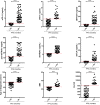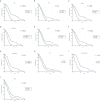Can circulating PD-1, PD-L1, BTN3A1, pan-BTN3As, BTN2A1 and BTLA levels enhance prognostic power of CA125 in patients with advanced high-grade serous ovarian cancer?
- PMID: 36212445
- PMCID: PMC9532861
- DOI: 10.3389/fonc.2022.946319
Can circulating PD-1, PD-L1, BTN3A1, pan-BTN3As, BTN2A1 and BTLA levels enhance prognostic power of CA125 in patients with advanced high-grade serous ovarian cancer?
Abstract
The most common subtype of ovarian cancer (OC) is the high-grade serous ovarian carcinoma (HGSOC), accounting for 70%-80% of all OC deaths. Although HGSOC is a potentially immunogenic tumor, clinical studies assessing the effectiveness of inhibitors of programmed death protein and its ligand (PD-1/PD-L1) in OC patients so far showed only response rates <15%. However, recent studies revealed an interesting prognostic role of plasma PD-1/PD-L1 and other circulating immunoregulatory molecules, such as the B- and T-lymphocyte attenuator (BTLA), butyrophilin sub-family 3A/CD277 receptors (BTN3A), and butyrophilin sub-family 2 member A1 (BTN2A1), in several solid tumors. Since evidence showed the prognostic relevance of pretreatment serum CA125 levels in OC, the aim of our study was to investigate if soluble forms of inhibitory immune checkpoints can enhance prognostic power of CA125 in advanced HGSOC women. Using specific ELISA tests, we examined the circulating PD-1, PD-L1, pan-BTN3As, BTN3A1, BTN2A1, and BTLA levels in 100 advanced HGSOC patients before treatment, correlating them with baseline serum CA125, age at diagnosis, body mass index (BMI), and peritoneal carcinomatosis. A multivariate analysis revealed that plasma BTN3A1 ≤4.75 ng/ml (HR, 1.94; 95% CI, 1.23-3.07; p=0.004), age at diagnosis ≤60 years (HR, 1.65; 95% CI, 1.05-2.59; p=0.03) and absence of peritoneal carcinomatosis (HR, 2.65; 95% CI, 1.66-4.22; p<0.0001) were independent prognostic factors for a longer progression-free survival (PFS) (≥30 months) in advanced HGSOC women. However, further two-factor multivariate analyses highlighted that baseline serum CA125 levels >401 U/ml and each soluble protein above respective concentration cutoff were covariates associated with shorter PFS (<30 months) and unfavorable clinical outcome, suggesting that contemporary measurement of both biomarkers than CA125 only could strengthen prognostic power of serum CA125 in predicting PFS of advanced HGSOC women. Plasma PD-L1, PD-1, BTN3A1, pan-sBTN3As, BTN2A1, or BTLA levels could be helpful biomarkers to increase prognostic value of CA125.
Keywords: BTLA; HGSOC; PD-1; PD-L1; butyrophilins; circulating immune checkpoints; prognostic factors; serum CA125.
Copyright © 2022 Fanale, Corsini, Brando, Cutaia, Di Donna, Filorizzo, Lisanti, Randazzo, Magrin, Romano, Bazan Russo, Olive, Vieni, Pantuso, Chiantera, Russo, Bazan and Iovanna.
Conflict of interest statement
JLI is cofounder of PanCa Therapeutics and PredicitngMed. The remaining authors declare that the research was conducted in the absence of any commercial or financial relationships that could be construed as a potential conflict of interest.
Figures



Similar articles
-
Low plasma PD-L1 levels, early tumor onset and absence of peritoneal carcinomatosis improve prognosis of women with advanced high-grade serous ovarian cancer.BMC Cancer. 2023 May 13;23(1):437. doi: 10.1186/s12885-023-10911-5. BMC Cancer. 2023. PMID: 37179293 Free PMC article.
-
Prognostic Role of Plasma PD-1, PD-L1, pan-BTN3As and BTN3A1 in Patients Affected by Metastatic Gastrointestinal Stromal Tumors: Can Immune Checkpoints Act as a Sentinel for Short-Term Survival?Cancers (Basel). 2021 Apr 27;13(9):2118. doi: 10.3390/cancers13092118. Cancers (Basel). 2021. PMID: 33925671 Free PMC article.
-
Prognostic significance of circulating PD-1, PD-L1, pan-BTN3As, BTN3A1 and BTLA in patients with pancreatic adenocarcinoma.Oncoimmunology. 2019 Feb 3;8(4):e1561120. doi: 10.1080/2162402X.2018.1561120. eCollection 2019. Oncoimmunology. 2019. PMID: 30906655 Free PMC article.
-
Prognostic significance of programmed cell death-ligand 1 expression on circulating tumor cells in various cancers: A systematic review and meta-analysis.Cancer Med. 2021 Oct;10(20):7021-7039. doi: 10.1002/cam4.4236. Epub 2021 Aug 23. Cancer Med. 2021. PMID: 34423578 Free PMC article.
-
Predictive Values of Programmed Cell Death-Ligand 1 Expression for Prognosis, Clinicopathological Factors, and Response to Programmed Cell Death-1/Programmed Cell Death-Ligand 1 Inhibitors in Patients With Gynecological Cancers: A Meta-Analysis.Front Oncol. 2021 Feb 1;10:572203. doi: 10.3389/fonc.2020.572203. eCollection 2020. Front Oncol. 2021. PMID: 33634012 Free PMC article.
Cited by
-
Analysis of prognostic value of lactate metabolism-related genes in ovarian cancer based on bioinformatics.J Ovarian Res. 2024 May 22;17(1):110. doi: 10.1186/s13048-024-01426-z. J Ovarian Res. 2024. PMID: 38778371 Free PMC article.
-
Immune Checkpoint Inhibitors-Related Myocarditis: A Review of Reported Clinical Cases.Diagnostics (Basel). 2023 Mar 25;13(7):1243. doi: 10.3390/diagnostics13071243. Diagnostics (Basel). 2023. PMID: 37046461 Free PMC article. Review.
-
Beyond the anti-PD-1/PD-L1 era: promising role of the BTLA/HVEM axis as a future target for cancer immunotherapy.Mol Cancer. 2023 Aug 30;22(1):142. doi: 10.1186/s12943-023-01845-4. Mol Cancer. 2023. PMID: 37649037 Free PMC article. Review.
-
Low plasma PD-L1 levels, early tumor onset and absence of peritoneal carcinomatosis improve prognosis of women with advanced high-grade serous ovarian cancer.BMC Cancer. 2023 May 13;23(1):437. doi: 10.1186/s12885-023-10911-5. BMC Cancer. 2023. PMID: 37179293 Free PMC article.
-
Evolving landscape of detection and targeting miRNA/epigenetics for therapeutic strategies in ovarian cancer.Cancer Lett. 2024 Nov 29;611:217357. doi: 10.1016/j.canlet.2024.217357. Online ahead of print. Cancer Lett. 2024. PMID: 39615646 Review.
References
LinkOut - more resources
Full Text Sources
Research Materials
Miscellaneous

